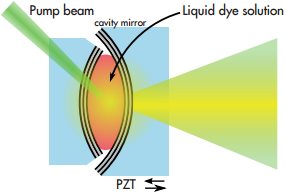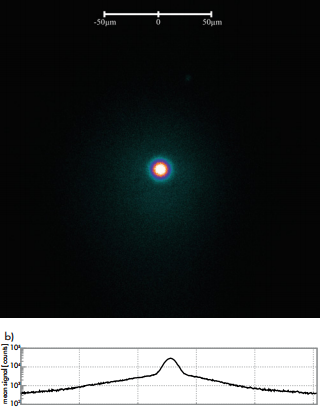Resources
 Part of the Oxford Instruments Group
Part of the Oxford Instruments Group
Expand
Collapse
 Part of the Oxford Instruments Group
Part of the Oxford Instruments Group

Figure 1: Dye-filled microcavity consisting of two spherically shaped high reflective dielectric mirrors. Typically we use Rhodamine 6G dye solved in methanol or ethylene glycol both as a heat bath and a particle reservoir. The mirror separation and thus the position of the low energy cutoff is actively controlled using piezo actuation.
Bose-Einstein condensation, the macroscopic ground state population of a system of integer spin particles below a critical temperature, has in the last 20 years been observed for cold atomic gases and solid state quasiparticles as exciton polaritons. The most widely known example of a photonic gas, blackbody radiation, however exhibits no Bose-Einstein condensation. In 2010 it was shown that in a small optical cavity with a low-frequency cutoff imprinting a spectrum of photon energies restricted to well above the thermal energies, Bose-Einstein condensation of photons can be achieved in a dye-filled optical microcavity [1]. The experiment involves thermalization of the photon gas to room temperature by absorption and re-emission processes on dye molecules. The results hold prospects for the exploration of novel states of light, e.g. also in periodic potentials, and for light sources in new wavelength regimes.
Experiment
For blackbody radiation it is known that cooling down the photon box to low temperatures does not lead to a formation of a BEC. Planck’s law here implies that photons will simply disappear in the system walls when lowering its temperature. To overcome this physical constraint we trap a photon gas in a dye-filled optical microcavity with a mirror spacing in the wavelength regime, providing both a photon-number conserving thermalization process and a non-trivial ground state for the photon gas.

Figure 2: a) Image of the emitted cavity light with ground mode (white) on top of a thermal photon cloud. The shown image was taken using an EM gain of 250 utilizing the full register depth. b) Horizontal cut through the image. The data set has sufficient dynamic range at negligible noise floor to clearly reveal the bimodal distribution of thermal cloud and highly populated condensate mode.
Our optical microresonator consists of two spherically curved dielectric mirrors with a reflectivity of above 99.9975%, separated by 1.5 µm (Fig. 1). The free spectral range exceeds the spectral width of the fluorescence of the used dye solution inside the cavity, effectively freezing out the longitudinal degree of freedom and making the system effectively two-dimensional [2]. The used dye, Rhodamine6G solved in Methanol, exhibits a quantum efficiency near 100% and spectrally emits light between 550 nm and 600 nm.
While the emitted light of the cavity ground mode propagates on the optical axis, higher transversal modes have a larger divergence angle, making it challenging to properly image the entire photon gas onto a detector.
We use a pump laser near 532 nm wavelength to excite the dye molecules. Prolonged pumping of the organic dye leads to triplet state excitations, degrading the luminosity of our system. The laser is therefore accoustooptically chopped to pulses of typically 500 ns length at a repetition rate below 100 Hz. The resulting number of photons leaving the cavity in one shot is of order 107.
In current experiments we are very successfully using the iXon Ultra 897 EMCCD camera (DU897 UCS-BV from Andor Technology) for spatial imaging of the emitted cavity light. Figure 2 shows an image of a highly occupied ground state (N0/N > 60%) surrounded by higher energy photons forming the thermal cloud. Here we make use of the high dynamic range and single photon detection sensitivity of the iXon camera to gain full knowledge of the bimodal spatial distribution in a single shot.
References
